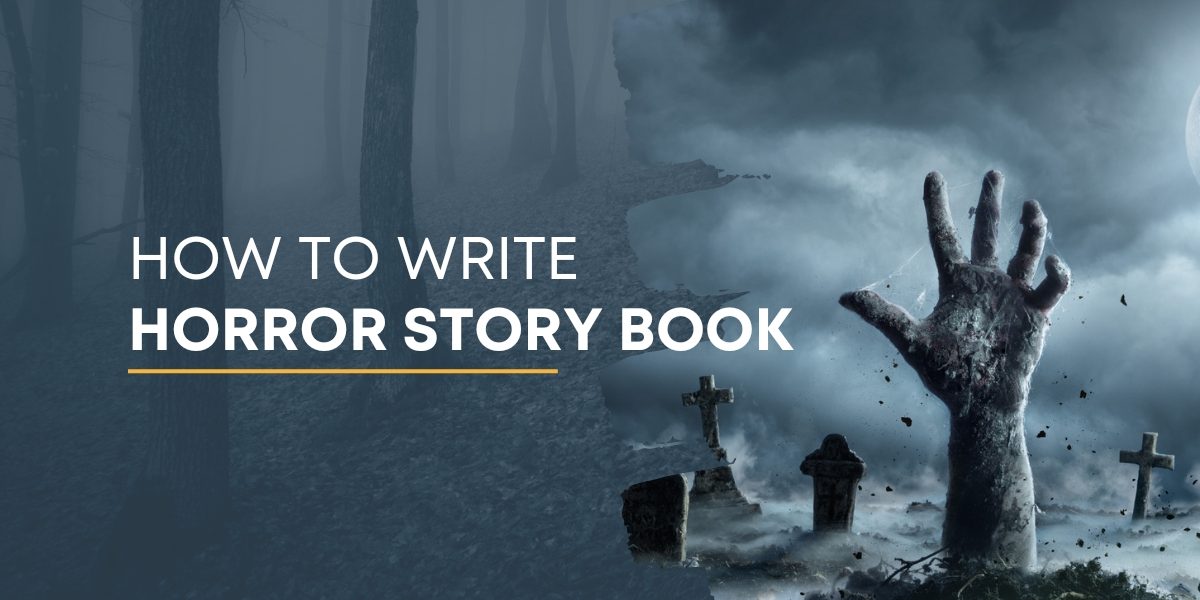Heart beating rapidly, hairs rising at the back of your neck, and sweat forming on your forehead as you anxiously wait for what happens next – the experience of reading a horror story book cannot be described in words, and that’s quite ironic. If you wish to bring out all these emotions and reactions in your readers, you must learn how to cook up content that taps into the reader’s paranoia. Unlike most other genres, writing a horror novel is tricky. So, without much ado, let us share how to write a horror story for book publishing.
The Ingredients of a Bestselling Horror Story Book
It’s the chase and the fear of the unknown that’s creepy and blood rising.
In book publishing, horror is a genre that brings out the strongest emotion in humans – Fear. Often, horror novel writing is included in the broader category of thrillers. But not all horror books have thrills.
To write a classic horror story book, you must tap into subjects that frighten humans the most, such as demons, ghosts, the devil, golems, etc.
However, Gothic horror is the trending genre in 21st-century novels where werewolves, vampires, zombies, serial killers, and other predicaments of supernatural play villains.
In Truth, The Closest Comparison to Writing Horror is Writing Comedy Books
Believe it or not, these two genres are closely related because both attempt to subvert relatable situations and familiar settings.
In comedy fiction writing, a relatable situation, like marriage, is humored by something incongruous.
On the other hand, when authors write a horror book, they subvert the familiar – such as a new house, an antique jewelry box, camping in old ruins, a hotel stay, a summer house, or riding through the wood at night – with terror.
The reader’s reactions when reading horror or comedy stem from the same place – surprise or shock at how a normal situation was destabilized.
The familiarity of these settings prepares the readers for the terror lurking behind the words.
So, you must ensure the leading character’s perspective or point of view reflects that of your readers. Only then will it be scary when the lead character encounters a moment of fear.
For example, it is more terrifying when a young boy walking home through a wood is snatched deeper into the forest by a faceless creature than when an alien encounters a faceless creature.
Elements of Horror Story Books You Shouldn’t Miss Adding
Whenever an aspiring writer consults us on how to write a horror story book, we ask them to include these four elements without fail.
Unabashed Fear: Creating something truly fearful for an adult reader is harder than you think. We all fear different things in life. But a classic horror story creates fear out of a situation that the readers would never expect.
For example, you might not have feared clowns before reading Stephen King’s IT.
Shock or Surprise: A common reaction after facing the unknown is shock and surprise. Therefore, adding elements of surprise, shock, and disbelief will work well in instilling fear in your readers’ minds.
Disgust: An excellent horror storybook will make readers feel repulsed over a situation or character, such as the orcs eating humans from J R R Tolkien’s Lord of the Rings.
Horror or Dread: Finally, writing a true horror storybook requires you to step up from other emotions. Combine all three elements of shock, disgust, and fear, and produce the final element: your imagination of true evil, which you must cultivate in your reader’s mind with words.
How to Write a Horror Story Book: Tips and Tricks
Like all fiction writing, horror story books have no rules unless adapted from a true story – you can choose any subject or length and go all creative. Here are a few guidelines for writing horror story books for adults and young adults from the minds of Writat experts.
Read More Horror Books
There’s no better way to ace the craft of writing horror novels than to read horror stories yourself. Reading will grow your imagination, help you learn how to write horror story books in different ways, and make you a better writer.
But make sure you read the best from the lot, such as Stephen King, Lovecraft, Robert Bloch, and RL Stine.
Make the Story Personal
You will be surprised to know that when it comes to horror book publishing, more readers buy novels based on real-life stories. A real-life experience will garner more attention than a piece of imagination.
Tap into Your Inner Fears
To publish a good horror book, you must be honest with your writing. And the best way to do so is by tapping into your inner fears and writing them down to create a rough manuscript. Besides, if you can scare yourself, you will do a better job at scaring your readers.
Understand that Real Horror Can be Scarier than the Strange
Between Paranormal Activity, The Signs, and The Hills Have Eyes, which movie scared you the most? There’s a reason why you haven’t stopped talking about the Conjuring, Paranormal Activity, and Blair Witch Project because the movies still scare you when you are home alone. If you observe, neither of these movies had gory creatures as bad guys.
Sure, you can make your antagonist a severed-head grotesque creature from the mountain with black teeth and googly eyes, but will they really scare your reader for the longest time?
Classic horror books stick with the reader longer than a moment’s scare. And they toy with people’s feelings, the idea of the horror, more than just grossing them out.
Think as a Child
The best horror story books are those that revolve around everyday life. Horror always lies in the folds of simplicity. You must think like a child and avoid unheard-of horrors or complicating your story.
Use the common fears most people have as your novel background and setting, and start stitching your story together.
Give Your Characters a Reason to Exist
Developing characters in horror books is much more complicated than in other novel genres because you have to make the characters more believable.
While the bizarre characters, such as the demon, zombie, werewolf, or vampire, can be a little crazy and out-of-the-box, the lead role must be as human as possible.
However, they must also be brave and have a purpose. Even the villain must exist in your novel to do something – they should have a reason for the terror they cause.
And your purpose must be to make your readers feel your characters and establish an empathetic connection with them.
Leave Room for Reader’s Imagination
When foreshadowing the story, be subtle. Sometimes our greatest fears are our imagination. And our minds are most tumultuous at night.
That’s why people read and watch horror fiction at night.
And it is important to allow your readers to form their own fears and evils as they read your book. There is no fun if the story or ending is predictable.
Create suspense throughout the novel, manipulate your readers with misdirecting plot twits, and occasionally, send your readers screaming in anxiety.
The Novel’s Plot Pace Must be Slow and Steady
There is a difference between writing horror novels and thriller novels. Thrillers are generally fast-paced and filled with a lot of drama and action. However, horror novels are slower-paced. Authors do this intentionally to create a sense of tension and dread among the readers.
The slower the pace, the more anxiety, and excitement. You can achieve a slower story pace by explaining various elements with terrifying representations and adding engrossing, confrontational dialogues.
Whether your dream is publishing a series of horror novels or writing is your hobby, remember to spend a reasonable amount of time researching your subject before you start writing your horror storybook.
Want to self-publish a book or looking for affordable book publishing assistance, such as editing, cover designing, illustration, and author website development? Writat offers exclusive self-publishing packages and standalone services for publishing horror books.
Look at our benefits here.





